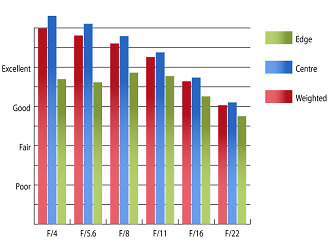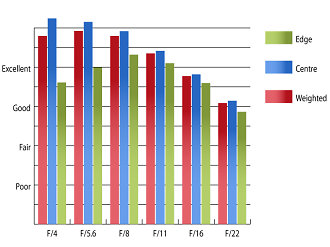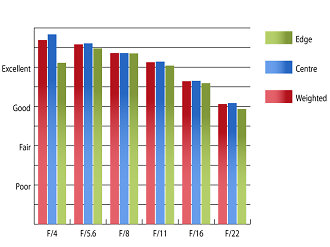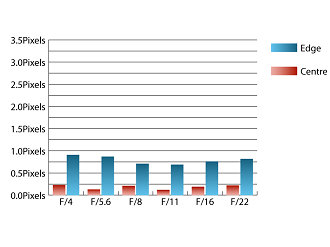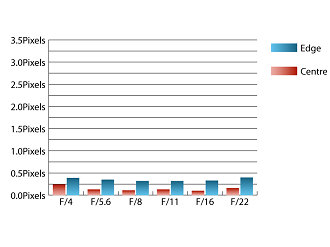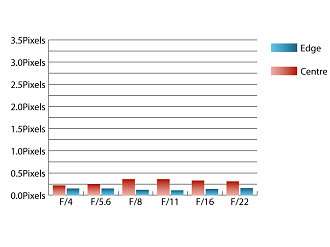Canon EF 11-24mm f/4L USM Review
Canon EF 11-24mm f/4L USM Performance
Between 11mm and 16mm, sharpness is already outstanding in the centre of the frame at maximum aperture, with performance towards the edges of the frame being very good. At 11mm, stopping down results in little improvement in clarity towards the edges of the frame, but at 16mm, excellent performance is realised with the aperture stopped down to f/8.
At 24mm, sharpness remains outstanding in the centre of the frame at maximum aperture, and excellent towards the edges of the frame. Stopping down to f/4 results in outstanding sharpness across the frame.
How to read our charts
The blue column represents readings from the centre of the picture frame at the various apertures and the green is from the edges. Averaging them out gives the red weighted column.The scale on the left side is an indication of actual image resolution. The taller the column, the better the lens performance. Simple.
For this review, the lens was tested on a Canon EOS 5D MK III using Imatest.
Chromatic aberrations are well controlled for a lens this wide, just approaching a pixel width at f/4 and 11mm. This low level should cause few issues, even in large prints and harsh crops from the edges of the frame.
How to read our charts
Chromatic aberration is the lens' inability to focus on the sensor or film all colours of visible light at the same point. Severe chromatic aberration gives a noticeable fringing or a halo effect around sharp edges within the picture. It can be cured in software.Apochromatic lenses have special lens elements (aspheric, extra-low dispersion etc) to minimize the problem, hence they usually cost more.
For this review, the lens was tested on a Canon EOS 5D MK III using Imatest.
Falloff of illumination towards the corners of the frame is reasonably well controlled for a lens covering such a wide angle of view, with the corners being 2.84 stops darker than the image centre at 11mm and 1.3 stops darker than the centre at 24mm. Visually uniform illumination is achieved with the lens stopped down to f/8 throughout the zoom range.
Distortion is reasonable for a lens of this type. At 11mm 6.9% barrel distortion is present, which is replaced by a negligible amount of barrel distortion at 24mm. The distortion pattern has a very slight wave, being present in straight lines parallel to the edge of the frame. This may make applying corrections in image editing software afterwards more tricky, unless the software you use has a preset distortion profile to use.
This lens is very resistant to flare and contrast is excellent, even when shooting into the light.
Value For Money
It's difficult to talk about value for money with a lens like this. At the time of writing, it's unique. The price of £2800 will be beyond the reach of may photographers, so I suppose it boils down to whether the 11mm focal length is worth it for you.
Add your message
Please login here or if you've not registered, you can register here. Registering is safe, quick and free.
photodo Stats
428 MTF tests
74 in-depth photodo reviews
100+ users join each day
Help the lens community by reviewing or rating a lens today via our lens search
Latest Lens Reviews
- Chinon 28mm f/2.8 Vintage Lens Review
- Canon EF 70-200mm f/4L IS II USM Lens Review
- Samyang AF 85mm f/1.4 EF Review
- Sigma 70mm f/2.8 DG Macro Art Review
- Samyang AF 24mm f/2.8 FE Review
- Meike 50mm f/1.7 Review
- Tamron 70-210mm f/4 Di VC USD Review
- Lensbaby Burnside 35mm f/2.8 Review
- Asahi Super Takumar 50mm f/1.4 Review
- Asahi Super-Multi-Coated Takumar 135mm f/3.5 Review
